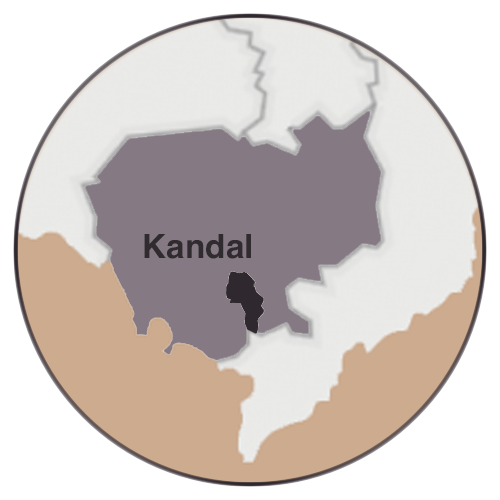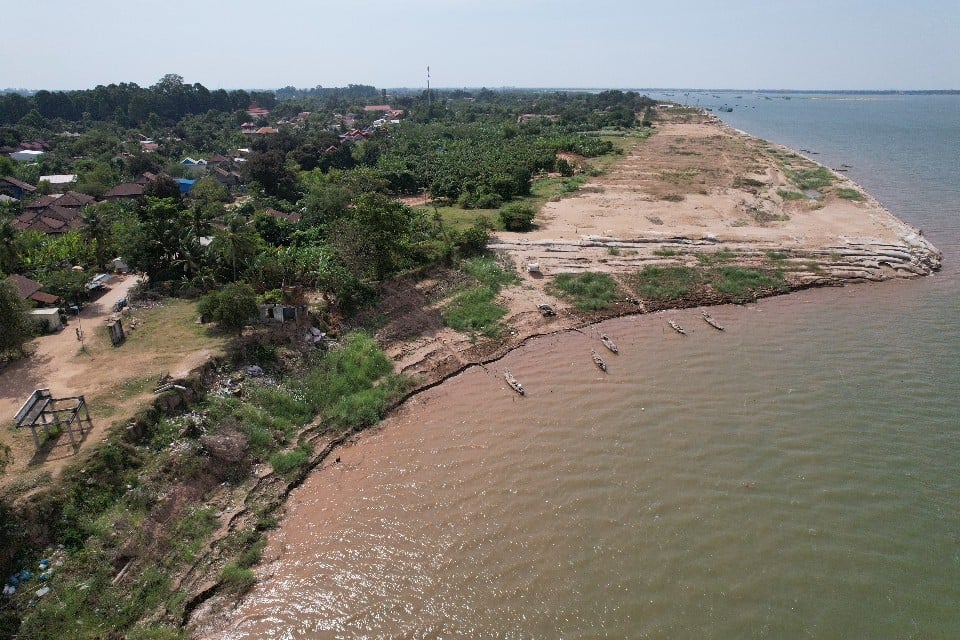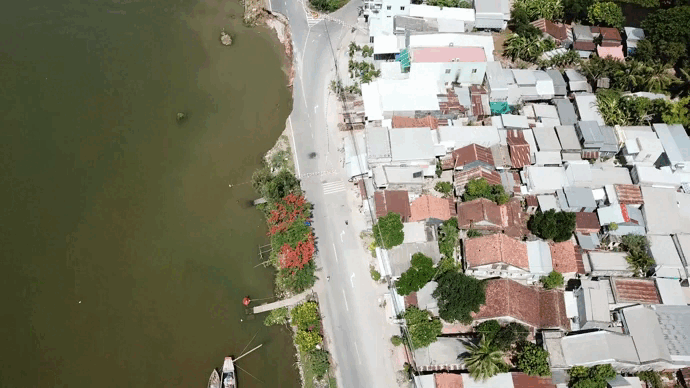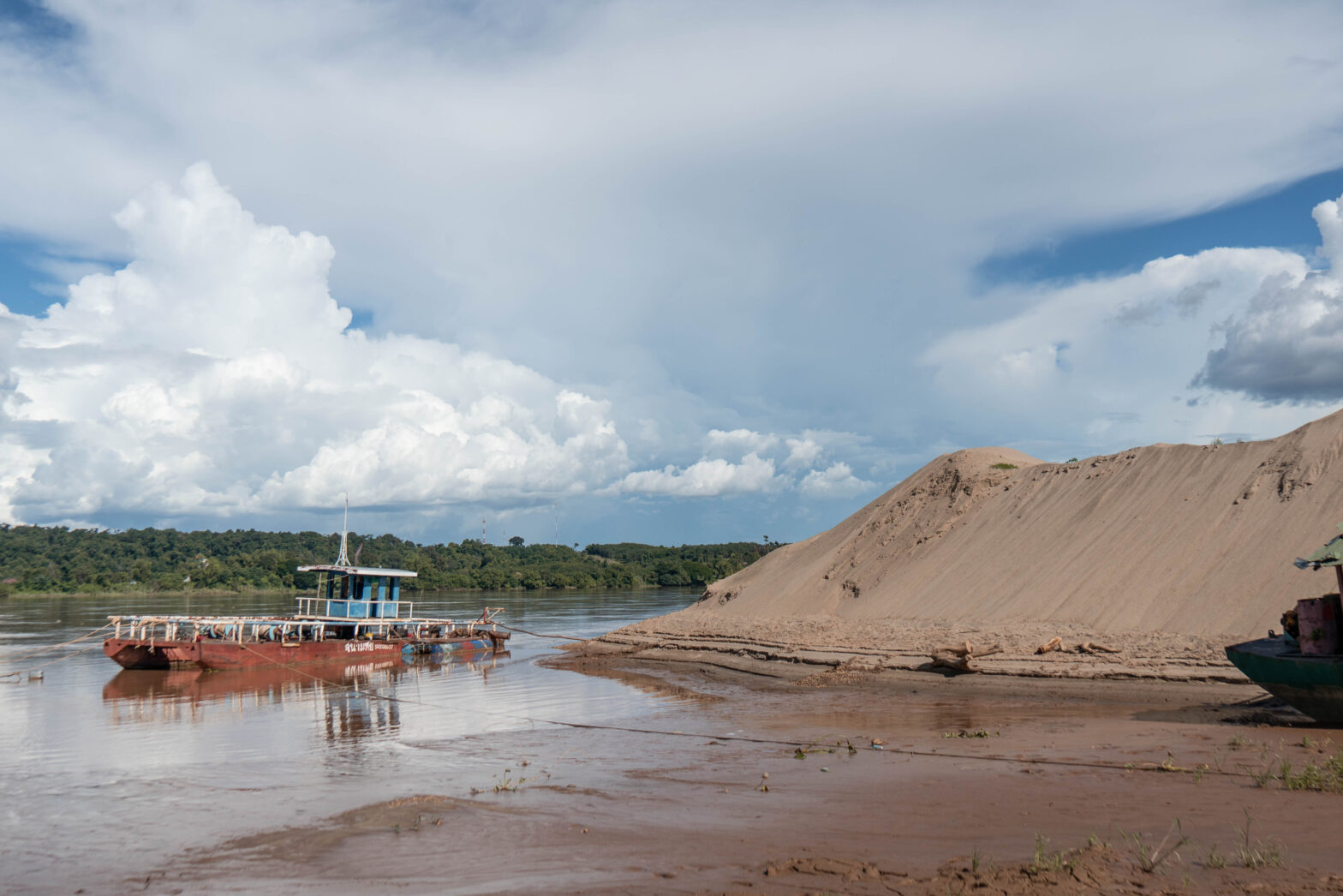The high level of corruption in Cambodia undermined the public’s trust in the government’s regulations on the sand mining industry.

KANDAL, CAMBODIA – Sor Sok Lang, a resident of Ta Ek commune in Kandal province, 40 kilometers from Cambodia’s capital Phnom Penh, has thought about leaving her house on the banks of the Mekong River – where she watches her land get eaten up by the river every year.
Back in 2011, part of her wooden house was lost when the riverbank collapsed. The whole house, as well as her grocery business, was swept away five years later.
She then rebuilt a home for her family of five using corrugated metal sheets. But her family’s lives remain full of uncertainty.
“When there was a strong wind, I felt frustrated and scared due to a fear of the house collapsing,” said Sok Lang. “Who would not get scared?”
Residents in her community believe a series of riverbank collapses were linked to rampant sand mining, where sand is scooped up from the river, which in turn destabilizes the river’s banks.
The Mekong River in Kandal province is one of Cambodia’s most popular sand extraction sites.
Although dredging is allowed from 6am to 6pm, Sok Lang can hear the roar of machines throughout the night. The dredging ships rarely stop carrying the sand from the mining sites to unknown destinations.
She believes this sand will be used for construction in her community too, where developers eye the panoramic views of the Mekong River as increasing the value of their future luxury condominiums and resorts.
In the past decade, Cambodia’s hunger for sand was intensified by its pursuit of economic prosperity. Urbanization and infrastructure, especially road networks, have been rapidly expanded.
Its construction sector is projected to grow 9.4% between 2023 and 2026 due to ongoing investments in infrastructure, commercial and residential buildings and the strong demand for real estate.
“Our estimates in Cambodia alone in 2020, rates of extraction were around 59 million tons a year compared to the previous estimation in 2011, which was around 32 million tons a year. So it’s almost double,” said Christopher Hackney, a research fellow at the School of Geography, Politics and Sociology at Newcastle University.
“It is significantly more than what the river can naturally deliver and that’s where the environmental issues start to kick in. Because if you’re not replacing that sand, then you start degrading the Mekong and the environmental systems that the Mekong support.”
Unstable riverbank
In fear of erosion, local villagers abandoned their houses on the banks of the Mekong River in Kandal province. PHOTO: Chhorn Sophat
A recent study, led by Hackney, used monthly high-resolution satellite imagery to track sand barges and estimate the volumes of sand extracted throughout the Mekong River in Cambodia. It showed an increase in the rate of sand extraction from 24 million tons in 2016 to 59 million tons in 2020.
This rapid loss of sand can cause disasters in many ways, including the devastation of animal habitats and fish breeding grounds and sediment loss downstream in Vietnam that increases the risk of saline intrusion.
Riverbank erosion is the main impact that has been reported across Cambodia and Vietnam.
Another study, also led by Hackney and published in 2020 in Nature Sustainability, pointed out that when sand was removed, the river bed levels can fall and induce river bank instability, which potentially damages housing and infrastructure.
“You only need to lower the riverbed by about three meters to cause the riverbanks to start eroding more frequently. It becomes more unstable. That three-meter lowering is something that could happen in the next five years. It may already have happened,” said Hackney.
His research team is studying the potential impact of sand mining around Phnom Penh on the hydraulic flow into the Tonle Sap Lake, much of which is fed by the Mekong River.
As the sand extraction lowers the riverbed, it likely changes the water flow between the Mekong and Tonle Sap, which also affects the ecology, fisheries and livelihoods the Tonle Sap Lake supports.
According to an interview with Ung Dipola, the Director of Cambodia’s Mineral Resources Department, the Hun Sen government issued 49 sand mining licenses for the Mekong and Bassac rivers to 49 companies, mostly Cambodian.
Of these companies, 43 operate in the Mekong River. The mining areas are equivalent to 3.7% of the two rivers’ water surface.
In 2021 and 2022, domestic sand consumption was 13 million and 10 million cubic meters (nearly 20 million and 15 million tons), respectively.
Killing two birds with one stone
A sand barge is parked next to a sand storage depot in Cambodia’s Kandal province where sand from the Mekong River is collected and loaded onto trucks. PHOTO: Chhorn Sophat
Cambodia banned sand exports to all countries, except Vietnam, in 2017 in response to environmental concerns, said Dipola, who also confirmed that extracted sand was mainly used and sold in the domestic market.
However, only two companies – Chaktomuk Resources Supply Import Export Co Ltd and Global Green Energy Development Co Ltd – are allowed to export sand to Vietnam, where demand has increased due to a construction boom.
According to a Pulitzer Center investigation, Global Green Energy Development was until last year headed by Try Dalin, the daughter of businessman Try Pheap, who has served as an adviser to Prime Minister Hun Sen and had close ties with the military and government officials.
He was sanctioned by the US Department of the Treasury’s Office of Foreign Assets Control in December 2019 in relation to alleged corruption and a massive illegal logging operation.
In 2021 and 2022, about four million cubic meters (around six million tons) of sand was exported to Vietnam, generating about US$8 million in a tax levy to the government. Of this, nearly $7 million was export tax and $400,000 went to the national development fund.
“Sand mining is a business that can kill two birds with one stone. It can generate revenue for the nation while contributing to the country’s development,” said Dipola.
Despite environmental concerns, Dipola said the Cambodian government could minimize the impact of sand mining through a social and environmental impact assessment, where companies applying for a mining license must pass an evaluation conducted by the Ministry of Mines and Energy’s working group.
“Sand dredging will cause riverbank collapses if the operation does not follow the rules and technical guidelines set by the ministry,” he said, adding that this was not the case in Cambodia.
He claimed the government had regulated sand mining effectively while limiting the number of miners and areas to avoid environmental catastrophes. Other factors likely cause riverbank collapses, such as strong currents and residential water discharged into the river, he said.
Lack of data access
The remnants of an unfinished house next to the Mekong River in Ta Ek commune in Cambodia’s Kandal province. Many residents there left their lands and houses because they feared the river’s banks would collapse. PHOTO: Chhorn Sophat
But for many environmental activists, the Cambodian government’s claims were not sufficient to convince them of the low impact of sand mining.
One of those was San Mala, an environmental activist who was jailed for almost one year and was released in 2016 after criticizing the sand mining industry in Cambodia’s southern Koh Kong province.
He has called for open data on sand mining to ensure transparency in the industry and minimize its environmental impact. However, there is very little public data about sand mining, including extraction volumes, locations of sand usage and companies’ revenues.
Meanwhile, the high level of corruption in Cambodia had undermined the public’s trust in the government, especially in its regulations on the extraction industry, which often involves high-profile tycoons or people linked to government figures.
Cambodia was ranked 150th out of 180 countries with the least corruption in Transparency International’s 2022 Corruption Perceptions Index.
In 2016, a controversy erupted in Cambodia when almost 50 civil society organizations called on the government to join many other Southeast Asian nations and ban or severely restrict sand exports to Singapore after media inquiries revealed that almost $750 million worth of sand from the country was unaccounted for.
UN data showed Cambodia had exported $752 million worth of sand to Singapore over the previous eight years. However, officials in Phnom Penh only reported that about $5 million worth of sand had been exported to Singapore.
The discrepancy of more than $700 million was denied by Cambodian officials, who threatened to sue media outlets reporting on the subject.
“We note the decisions of the governments of Vietnam, Indonesia and Malaysia to ban or restrict sand exports to Singapore due to environmental concerns, and we urge your excellency to consider instituting a similar ban or restriction in Cambodia, in the interests of Cambodia’s long-term sustainable development,” wrote the 47 groups in an October 31, 2016, letter to Minister of Mines and Energy Suy Sem, according to Radio Free Asia.
The ministry responded and attempted to deflect criticism, blaming the use of different reporting regimes by different countries on the conflicting figures.
Now the Cambodian government controls most media outlets and the few independent ones are wary of reporting any similar stories, but large-scale sand mining continues.
“Without the release of public data, it is not wrong to doubt that the profits from the dredging business will benefit only a handful of rich people,” said Mala. “It is also difficult to ensure that government practices are effective, of any quality and transparent.”
He added that people linked sand dredging to riverbank collapses partly because they don’t find the government transparent and accountable.
A lost second chance
A woman sells fish in front of her house on the bank of the Mekong River in Cambodia’s Kandal province. Access to the river provides the local community with food and incomes. PHOTO: Chhorn Sophat
In May, Sor Sok Lang, who lives in the Ta Ek commune, will move to her mother’s house far from the riverbank area where she can no longer stay due to the fear of losing her property again.
Many people in her community have already moved out or plan to sell their land to developers to avoid the risk of riverbank collapses. The departure of community members means fewer customers for her to rebuild her grocery business.
Her income will decrease if she stays, she said, and her family can’t win in a battle with the river.
After she lost her house and grocery business to a riverbank collapse in 2016, her 44-year-old husband Tong Peng Karng became the breadwinner of the family.
He earned about $25 a day from spraying herbicide on people’s plantations, and sometimes from fishing. But that amount is barely enough for a family of five, including three daughters, two of whom are in school.
The family has been in debt since losing their house and must pay $300 a month to a bank.
Karng Ghek Mouy, 20, the eldest daughter, had to end her dream of pursuing a law degree due to her family’s financial constraints. She will soon move to Phnom Penh to take a cashier’s job in a newly opened supermarket.
“We don’t know what the future will hold for our family. But for now, we only want the safety of all our family members,” said Sor Sok Lang, while making plans to leave the Mekong River.
This story is part of the “A Thirst for Sand” series, which was produced in partnership with the Environmental Reporting Collective. This partnership brings in journalists from 12 countries to expose how a weakly regulated industry overlooks the environmental destruction and human toll of the highly lucrative and low-risk business of sand mining.
A map used in this story is sourced from Mapbox.
Explore more stories:






